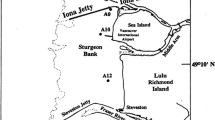Abstract
In this paper we describe a three-step procedure to infer the spatial heterogeneity in microphytobenthos primary productivity at the scale of tidal estuaries and embayments. The first step involves local measurement of the carbon assimilation rate of benthic microalgae to determine the parameters of the photosynthesis-irradiance (P-E) curves (using non-linear optimization methods). In the next step, a resampling technique is used to rebuild pseudo-sampling distributions of the local productivity estimates; these provide error estimates for determining the significance level of differences between sites. The third step combines the previous results with deterministic models of tidal elevation and solar irradiance to compute mean and variance of the daily areal primary productivity over an entire intertidal mudflat area within each embayment. This scheme was applied on three different intertidal mudflat regions of the San Francisco Bay estuary during autumn 1998. Microphytobenthos productivity exhibits strong (ca. 3-fold) significant differences among the major sub-basins of San Francisco Bay. This spatial heterogeneity is attributed to two main causes: significant differences in the photosynthetic competence (P-E parameters) of the microphytobenthos in the different sub-basins, and spatial differences in the phase shifts between the tidal and solar cycles controlling the exposure of intertidal areas to sunlight. The procedure is general and can be used in other estuaries to assess the magnitude and patterns of spatial variability of microphytobenthos productivity at the level of the ecosystems.
Similar content being viewed by others
Literature Cited
Admiraal, W. 1977. Salinity tolerance of benthic estuarine diatoms as tested with a rapid polarographic measurement of photosynthesis.Marine Biology 39:11–19.
Admiraal, W. 1984. The ecology of estuarine sediment-inhabiting diatoms, p. 269–322.In F. E. Round and D. J. Chapman (eds.), Progress in Physiological Research, Volume 3. Biopress Ltd., Bristol, U.K.
Alpine, A. E. andJ. E. Cloern. 1988. Phytoplankton growth rates in a light-limited environment, San Francisco Bay.Marine Ecology Progress Series 44:167–173.
Alpine, A. E. andJ. E. Cloern. 1992. Trophic interactions and direct physical effects control phytoplankton biomass and production in estuary.Limnology and Oceanography 37:946–955.
Blanchard, G. F., J.-M. Guarini, P. Gros, andP. Richard. 1997. Seasonal effect of the relationship between the photosynthetic capacity of intertidal microphytobenthos and temperature.Journal of Phycology 33:723–728.
Cheng, R. T. andJ. W. Gartner. 1984. Tides, tidal and residual currents in San Francisco Bay, California: Results of measurements, 1979–1980. Investigations Report 84-4339. U.S. Geological Survey Water Resources, Menlo Park, California.
Cloern, J. E. 1987. Turbidity as a control on phytoplankton biomass and productivity in estuaries.Continental Shelf Research 7:1367–1381.
Cloern, J. E. 1996. Phytoplankton bloom dynamics in coastal systems: A review with some general lessons from sustained investigation of San Francisco Bay, California.Review of Geophysics 34:127–168.
Cullen, J. J. 1990. On models of growth and photosynthesis in phytoplankton.Deep-Sea Research 37:667–683.
Darley, W. M., E. L. Dunn, K. S. Holmes, andH. G. Larew. 1970. A14C method for measuring epibenthic microalgal productivity in air.Journal of Experimental Marine Biology and Ecology 25:207–217.
Efron, B. andR. Tibshirani. 1993. An Introduction to the Bootstrap. Chapman and Hall, London, U.K.
Frouin, R., D. W. Lingner, C. Gautier, K. S. Baker, andR. C. Smith. 1989. A simple analytical formula to compute clear sky total and photosynthetically available solar irradiance at the ocean surface.Journal of Geophysical Research 94:9731–9742.
Guarini, J. M., P. Gros, G. B. Blanchard, andC. Bacher. 1999. Short-term dynamics of intertidal microphytobenthic biomass. Mathematical modelling.Comptes Rendus de l'Académie des Sciences/Life Sciences 322:363–373.
Guarini, J. M., G. F. Blanchard, P. Gros, D. Gouleau, andC. Bacher. 2000. Dynamic model of the short-term variability of microphytobenthic biomass on temperate intertidal mudflats.Marine Ecology Progress Series 195:291–303.
Jassby, A. D., J. E. Cloern, andT. M. Powell. 1993. Organic carbon sources and sinks in San Francisco Bay: Variability induced by river flow.Marine Ecology Progress Series 95:39–54.
Jassby, A. D. andT. Platt. 1976. Mathematical formulation of the relationship between photosynthesis and light for phytoplankton.Limnology and Oceanography 21:540–547.
Kühl, M., C. Lassen, andB. B. Jörgensen. 1994. Light penetration and light intensity in sandy marine sediments measured with irradiance and scalar irradiance fiber-optic microprobes.Marine Ecology Progress Series 15:139–148.
Lewis, M. R. andJ. C. Smith. 1983. A small volume, short-incubation time method for measurement of photosynthesis as a function of incident irradiance.Marine Ecology Progress Series 13:99–102.
Nelder, V. A. andR. Mead. 1965. A simplex method for function minimization.The Computer Journal 7:308–313.
NOAA. 1998. National Ocean Service Hydrographic Survey Data. U.S. Coastal Waters. CD Version 4.0. North Atlantic Treaty Organization, National Geophysical Data Center Boulder, Colorado (http://www.ngdc.noaa.gov/mgg/fliers/98mgg03.html).
Parsons, T. R., Y. Maita, andC. M. Lali. 1984. A Manual of Chemical and Biological Methods for Sea Water Analysis. Pergamon Press, Oxford, U.K.
Pinckney, J. L. andR. G. Zingmark. 1993. Modelling the annual production of intertidal benthic microalgae in estuarine ecosystems.Journal of Phycology 29:396–407.
Rasmussen, M. B., K. Henriksen, andA. Jensen. 1983. Possible causes of temporal fluctuations in primary production of the microphytobenthos in the Danish Wadden Sea.Marine Biology 73:109–114.
Rubinstein, R. Y. 1981. Simulation and the Monte-Carlo Method. John Wiley and Sons, New York.
Serodio, J., J. M. Da Silva, andF. Catarino. 1998. Non destructive tracing of migratory rhythms of intertidal benthic microalgae using in vivo chlorophyll a fluoresence.Journal of Phycology 33:542–553.
Underwood, G. J. C. andJ. Krompkamp. 1999. Primary production by phytoplankton and microphytobenthos in estuaries.Advances in Ecological Research 29:93–153.
Walter, R. A., R. T. Cheng, andT. J. Conomos. 1985. Time scales of circulation and mixing processes of San Francisco Bay waters.Hydrobiologia 129:13–37.
Author information
Authors and Affiliations
Corresponding author
Rights and permissions
About this article
Cite this article
Guarini, JM., Cloern, J.E., Edmunds, J. et al. Microphytobenthic potential productivity estimated in three tidal embayments of the San Francisco Bay: A comparative study. Estuaries 25, 409–417 (2002). https://doi.org/10.1007/BF02695983
Received:
Accepted:
Issue Date:
DOI: https://doi.org/10.1007/BF02695983




